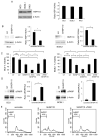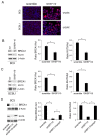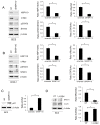HSP110 Inhibition in Primary Effusion Lymphoma Cells: One Molecule, Many Pro-Survival Targets
- PMID: 38067355
- PMCID: PMC10705194
- DOI: 10.3390/cancers15235651
HSP110 Inhibition in Primary Effusion Lymphoma Cells: One Molecule, Many Pro-Survival Targets
Abstract
Heat shock proteins (HSPs) are highly expressed in cancer cells and represent a promising target in anti-cancer therapy. In this study, we investigated for the first time the expression of high-molecular-weight HSP110, belonging to the HSP70 family of proteins, in Primary Effusion Lymphoma (PEL) and explored its role in their survival. This is a rare lymphoma associated with KSHV, for which an effective therapy remains to be discovered. The results obtained from this study suggest that targeting HSP110 could be a very promising strategy against PEL, as its silencing induced lysosomal membrane permeabilization, the cleavage of BID, caspase 8 activation, downregulated c-Myc, and strongly impaired the HR and NHEJ DNA repair pathways, leading to apoptotic cell death. Since chemical inhibitors of this HSP are not commercially available yet, this study encourages a more intense search in this direction in order to discover a new potential treatment that is effective against this and likely other B cell lymphomas that are known to overexpress HSP110.
Keywords: DDR; HSP110; PEL; apoptosis.
Conflict of interest statement
The authors declare no conflict of interest.
Figures




Similar articles
-
HSPs/STAT3 Interplay Sustains DDR and Promotes Cytokine Release by Primary Effusion Lymphoma Cells.Int J Mol Sci. 2023 Feb 15;24(4):3933. doi: 10.3390/ijms24043933. Int J Mol Sci. 2023. PMID: 36835344 Free PMC article.
-
Targeting c-Myc Unbalances UPR towards Cell Death and Impairs DDR in Lymphoma and Multiple Myeloma Cells.Biomedicines. 2022 Mar 22;10(4):731. doi: 10.3390/biomedicines10040731. Biomedicines. 2022. PMID: 35453482 Free PMC article.
-
HSP70 inhibition by 2-phenylethynesulfonamide induces lysosomal cathepsin D release and immunogenic cell death in primary effusion lymphoma.Cell Death Dis. 2013 Jul 18;4(7):e730. doi: 10.1038/cddis.2013.263. Cell Death Dis. 2013. PMID: 23868063 Free PMC article.
-
Heat-Shock Proteins in Leukemia and Lymphoma: Multitargets for Innovative Therapeutic Approaches.Cancers (Basel). 2023 Feb 3;15(3):984. doi: 10.3390/cancers15030984. Cancers (Basel). 2023. PMID: 36765939 Free PMC article. Review.
-
Clinical, Prognostic and Therapeutic Significance of Heat Shock Proteins in Cancer.Curr Drug Targets. 2018;19(13):1478-1490. doi: 10.2174/1389450118666170823121248. Curr Drug Targets. 2018. PMID: 28831912 Review.
Cited by
-
Post-Translational Modifications (PTMs) of mutp53 and Epigenetic Changes Induced by mutp53.Biology (Basel). 2024 Jul 8;13(7):508. doi: 10.3390/biology13070508. Biology (Basel). 2024. PMID: 39056701 Free PMC article. Review.
References
-
- Gilardini Montani M.S., Cecere N., Granato M., Romeo M.A., Falcinelli L., Ciciarelli U., D’Orazi G., Faggioni A., Cirone M. Mutant p53, Stabilized by Its Interplay with HSP90, Activates a Positive Feed-Back Loop Between NRF2 and p62 that Induces Chemo-Resistance to Apigenin in Pancreatic Cancer Cells. Cancers. 2019;11:703. doi: 10.3390/cancers11050703. - DOI - PMC - PubMed
Grants and funding
LinkOut - more resources
Full Text Sources
Miscellaneous

